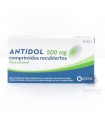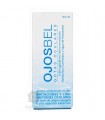Salvacoline is an antidiarrheal that reduces bowel movements and secretions, resulting in a decrease in liquid bowel movements.
Salvacoline is used for the symptomatic treatment of ineffectiveacutediarrheain adults and children over12 years of age.
You should see a doctor if it gets worse or if it does not improve after 2days.
1. What is Salvacolina and what is it used for?
Salvacolina is an antidiarrheal that reduces intestinal movements and secretions, which produces a decrease in liquid stools.
Salvacolina is used for the symptomatic treatment of acute diarrhea unspecific fic in adults and children over 12 years.
You must talk to a doctor if you do not feel better or if you feel worse after 2 days .
2. What you need to know before you start taking Salvacolina
Do not take Salvacolina
- If you are allergic to loperamide hydrochloride or any of the other ingredients of this medicine (listed in section 6).
- Do not administer to children under 2 years of age.
- If there is blood in the stool or you have a high fever (above 38 ° C).
- If you have been diagnosed with acute ulcerative colitis (inflammation of the intestine).
- If you suffer from severe diarrhea (pseudomembranous colitis) after taking antibiotics.
- If you suffer from diarrhea due to an infection caused by organisms such as Salmonella , Shigella, or Campylobacter.
Warnings and cautions
- Consult your doctor or pharmacist before taking Salvacolina.
- If no improvement is observed within 48 hours or fever, constipation or other symptoms such as abdominal swelling or paralytic ileus (absence of bowel movements) appear, stop treatment and consult your doctor.
- If you have severe diarrhea, your body loses more fluids, sugars, and salts than normal, so you will need to replace fluids by drinking more than usual. Dehydration is manifested by dry mouth, excessive thirst, decreased urination, wrinkled skin, dizziness, and lightheadedness. It is very important to prevent dehydration in children and the elderly.
- AIDS patients should discontinue treatment when the first symptoms of abdominal swelling appear.
- If you suffer from liver or kidney disease or blood disorders, consult your doctor before taking this medicine.
- Since the treatment of diarrhea with Salvacolina is only symptomatic, diarrhea should be treated based on its cause, whenever possible.
- Do not take this medicine for a use other than that indicated (see section 1) and never take more than the recommended amount (see section 3). Serious heart problems (symptoms of which include fast or irregular heartbeats) have been reported in patients who have taken an excessive amount of loperamide, the active substance in Salvacoline.
Children and adolescents
Do not use in children under 12 years of age without consulting a doctor.
Using Salvacolina with other medicines
Tell your doctor or pharmacist if you are taking, have recently taken or might take any other medicines.
In particular, tell your doctor or pharmacist if you are taking any of the following medicines:
- Ritonavir, saquinavir (used to treat HIV).
- Quinidine (used to treat heart rhythm disturbances).
- Desmopressin (used to treat central diabetes insipidus and nocturnal urinary incontinence in children).
- Itraconazole or ketoconazole (used to treat fungal infections).
- Gemfibrozil (used to lower cholesterol).
- St. John's wort (used to improve mood and treat mild depression).
- Valerian (used to treat mild states of nervousness and anxiety).
- Opioid pain relievers (used to treat very severe pain) may already increase the risk of severe constipation and central nervous system depression (eg, drowsiness or decreased consciousness).
- Broad-spectrum antibiotics as it can make diarrhea caused by antibiotics worse.
Salvacolina can enhance the action of similar drugs.
Pregnancy and breastfeeding
If you are pregnant or breast-feeding, think you might be pregnant or are planning to become pregnant, consult your doctor or pharmacist before using this medicine.
Pregnancy
The safety of using this medication during pregnancy has not been established, so pregnant women should not take this medication unless prescribed by a doctor.
Lactation
Lactating women should not use this medicine without consulting their doctor as small amounts of it can pass into breast milk.
Driving and using machines
Tiredness, dizziness or drowsiness may appear during the treatment of diarrhea with Salvacolina, so it is advisable not to use machinery or drive vehicles.
3. How to take Salvacolina
Follow exactly the instructions for administration of the medicine contained in this leaflet or those indicated by your doctor or pharmacist. If in doubt, ask your doctor or pharmacist again.
Adults:
2 tablets (4 mg of loperamide hydrochloride) as a starting dose, followed by 1 tablet (2 mg of loperamide hydrochloride) after each diarrheal stool. Do not take more than 8 tablets (16 mg of loperamide hydrochloride) a day.
Children over 12 years :
1 tablet (2 mg of loperamide hydrochloride) as a starting dose, followed by 1 tablet (2 mg of loperamide hydrochloride) after each diarrheal stool. In children, the maximum daily dose should be related to body weight:
Child weight | Maximum number of tablets per day |
From 27 Kg | Maximum 4 tablets |
From 34 Kg | Maximum 5 tablets |
From 40 Kg | Maximum 6 tablets |
From 47 Kg | Maximum 7 tablets |
Patients with liver disease
They should consult the doctor before taking this medicine.
This medicine is taken by mouth.
Take Salvacolina tablets with a full glass of water.
If you take more Salvacolina than you should
If you have taken too much Salvacolina, contact a doctor or hospital as soon as possible for help. Symptoms may include: increased heart rate, irregular heartbeat, abnormal heartbeat (these symptoms can have potentially serious and life-threatening consequences), muscle stiffness, uncoordinated movements, drowsiness, difficulty urinating, or weak breathing.
Children react more severely to high amounts of Salvacolina than adults. If a child takes an excessive amount or exhibits any of the above symptoms, call a doctor immediately.
In case of overdose or accidental ingestion, immediately consult your doctor or pharmacist or call the Toxicological Information Service, telephone (91) 562 04 20, indicating the medicine and the amount ingested.
If you forget to take Salvacolina
Do not take a double dose to make up for a forgotten dose.
If you have any further questions on the use of this medicine, ask your doctor or pharmacist.
4. Possible side effects
To the Like all medicines, this medicine can cause side effects, although not everybody gets them.
If you experience any of the following side effects, stop treatment and see your doctor : hypersensitivity reactions (redness, itching or swelling of the skin, difficulty swallowing or breathing), blisters or severe peeling of the skin, intestinal paralysis (absence of bowel movements or paralytic ileus), abdominal swelling (distention), severe abdominal pain, dilation of the large intestine (megacolon), and loss or decreased level of consciousness.
Commonly (may affect up to 1 in 10 patients) may occur: constipation, nausea, gas (flatulence), headache (migraine) , and dizziness.
Uncommonly (may affect up to 1 in 100 patients) the following may appear: vomiting, pain or unpleasant sensation in the upper-middle part of the stomach (dyspepsia), dry mouth, abdominal pain or discomfort , drowsiness and discoloration of the skin (rash ) .
In rare cases (may affect up to 1 in 1000 patients) the following may appear: intestinal paralysis (absence of bowel movements or paralytic ileus), abdominal swelling (distention), dilation of the large intestine (megacolon), loss or decreased level of consciousness, stupor ( general unconsciousness ), exaggerated tension in muscle tone (hypertonia), abnormal coordination, blistering of the skin (bullous eruptions, including Stevens-Johnson syndrome, erythema multiforme and toxic epidermal necrolysis), skin disorder leading to lesions and severe itching (urticaria), itching (pruritus), severe allergic reactions such as swelling of the lips, face, throat or tongue that may cause difficulty in swallowing or breathing (angioedema) including anaphylactic shock, decreased amount of urine (urinary retention ), constricted pupils (miosis) and tiredness (fatigue).
Communication of adverse effects
If you experience any side effects, talk to your doctor or FARMAC é utico, even if it comes to possible side effects not listed in this leaflet. You can also communicate directly through the Spanish Pharmacovigilance System for Medicinal Products for Human Use http://www.notificaram.es.
By reporting side effects you can help provide more information on the safety of this medicine .
5. How to store Salvacolina
Keep this medicine out of the sight and reach of children.
It does not require any special storage conditions.
Do not use this medicine after the expiry date which is stated on the carton after EXP. The expiration date is the last day of the month indicated.
Medicines must not be disposed of via wastewater or household waste. Deposit the containers and medications you do not need at the SIGRE Point of your pharmacy. If in doubt, ask your pharmacist how to dispose of unneeded medicine and containers. By doing this you will help protect the environment .
6. Package contents and additional information
Composition of Salvacolina
The active substance is: loperamide hydrochloride 2 mg per tablet.
The other ingredients are: mannitol (E-421), talc (E-553b), magnesium stearate (E-572), microcrystalline cellulose (E-460i), croscarmellose A, colloidal silica (E-551), iron oxide yellow (E-172).
What the product looks like and contents of the pack
The tablets are yellowish, round, flat, diametrically scored.
The score line is for dividing and facilitating swallowing, but not for dividing into equal doses.
Each pack contains 12 or 20 tablets housed in blister packs.
Holder of the marketing authorization and responsible for manufacturing
Laboratorios SALVAT , SA
Gall, 30-36
08950 Esplugues de Llobregat (Barcelona) SPAIN
Date of last revision of this leaflet: April 2017
Updated and detailed information on this medicine is available on the website of the Spanish Agency for Medicines and Health Products (AEMPS) http://www.aemps.gob.es





































